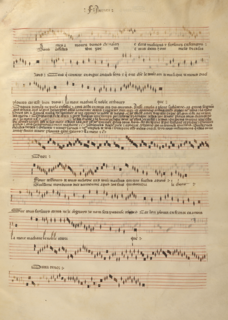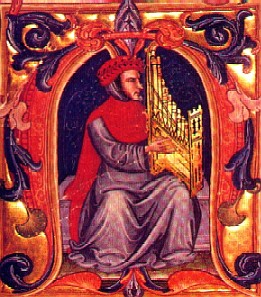Related Research Articles

In music, monophony is the simplest of musical textures, consisting of a melody, typically sung by a single singer or played by a single instrument player without accompanying harmony or chords. Many folk songs and traditional songs are monophonic. A melody is also considered to be monophonic if a group of singers sings the same melody together at the unison or with the same melody notes duplicated at the octave. If an entire melody is played by two or more instruments or sung by a choir with a fixed interval, such as a perfect fifth, it is also said to be monophony. The musical texture of a song or musical piece is determined by assessing whether varying components are used, such as an accompaniment part or polyphonic melody lines.
Jehan de Lescurel was a poet and composer of the late Medieval era.

Ars nova refers to a musical style which flourished in France and the Burgundian Low Countries in the late Middle Ages: more particularly, in the period between the preparation of the Roman de Fauvel (1310s) and the death of composer Guillaume de Machaut in 1377. The term is sometimes used more generally to refer to all European polyphonic music of the fourteenth century. For instance, "Italian ars nova" is sometimes used to denote the music of Francesco Landini and his compatriots. The "ars" in "ars nova" can be read as "technique", or "style". The term was first used in two musical treatises, titled Ars novae musicae by Johannes de Muris, and a collection of writings attributed to Philippe de Vitry often simply called "Ars nova" today. However, the term was first used to describe an historical era only by Johannes Wolf in 1904.
Martinus Fabri was a North Netherlandish composer of the late 14th century.

F. Andrieu was a French composer in the ars nova style of late medieval music. Nothing is known for certain about him except that he wrote Armes, amours/O flour des flours, a double ballade déploration, for the death of Guillaume de Machaut in 1377. The work has been widely praised and analyzed; it is notable for being one of two extant medieval double ballades for four voices, the only known contemporary musical setting of Eustache Deschamps and the earliest representative of the longstanding medieval and Renaissance lamentation tradition between composers. He may be the same person as Magister Franciscus, although the scholarly consensus on this identification is unclear. With P. des Molins, Jehan Vaillant and Grimace, Andrieu was one of the "post-Machaut" generation whose pieces retain enough ars nova qualities to be differentiated from composers of ars subtilior.
Nicolas Grenon was a French composer of the early Renaissance. He wrote in all the prevailing musical forms of the time, and was a rare case of a long-lived composer who learned his craft in the late 14th century but primarily practiced during the era during which the Renaissance styles were forming.
Jacopo da Bologna was an Italian composer of the Trecento, the period sometimes known as the Italian ars nova. He was one of the first composers of this group, making him a contemporary of Gherardello da Firenze and Giovanni da Firenze. He concentrated mainly on madrigals, including both canonic (caccia-madrigal) and non-canonic types, but also composed a single example each of a caccia, lauda-ballata, and motet.
Solage, possibly Jean So(u)lage, was a French composer, and probably also a poet. He composed the most pieces in the Chantilly Codex, the principal source of music of the ars subtilior, the manneristic compositional school centered on Avignon at the end of the century.

The Trecento was a period of vigorous activity in Italy in the arts, including painting, architecture, literature, and music. The music of the Trecento paralleled the achievements in the other arts in many ways, for example, in pioneering new forms of expression, especially in secular song in the vernacular language, Italian. In these regards, the music of the Trecento may seem more to be a Renaissance phenomenon; however, the predominant musical language was more closely related to that of the late Middle Ages, and musicologists generally classify the Trecento as the end of the medieval era. Trecento means "three hundred" in Italian but is usually used to refer to the 1300s. However, the greatest flowering of music in the Trecento happened late in the century, and the period is usually extended to include music up to around 1420.

The Chantilly Codex is a manuscript of medieval music containing pieces from the style known as the Ars subtilior. It is held in the museum at the Château de Chantilly in Chantilly, Oise.
The Ivrea Codex is a parchment manuscript containing a significant body of 14th century French polyphonic music.
Borlet was a 14th- and 15th-century composer whose life we know extremely little about. It is thought that his name is an anagram of Trebol, a French composer who served Martin of Aragon in 1409 at the same time as Gacian Reyneau and other composers in the Codex Chantilly.
Egardus was a European Medieval composer of ars subtilior. Almost no information survives about his life, and only three of his works are known. A certain "Johannes Ecghaerd", who held chaplaincies in Bruges and Diksmuide, may be a possible match for Egardus. The extant works—a canon and two Glorias—appear to be less complex than music by mid-century composers, possibly because they date from either very early or very late in Egardus' career.

Grimace was a French poet and composer of the ars nova style in late medieval music. Virtually nothing is known about Grimace's life other than speculative information based on the circumstances and content of his five surviving compositions of formes fixes; three ballades, a virelai and rondeau. He is though to have been a younger contemporary of Guillaume de Machaut and based in southern France. Three of his works were included in the Chantilly Codex, which is an important source of ars subtilior music. However, along with P. des Molins, Jehan Vaillant and F. Andrieu, Grimace was one of the post-Machaut generation whose music shows few distinctly ars subtilior features, leading scholars to recognize Grimace's work as closer to the ars nova style of Machaut. His most often performed work is the virelai and proto-battaglia: A l’arme A l’arme.
Jehan Vaillant was a French music composer and theorist. He is named immediately after Guillaume de Machaut by the Règles de la seconde rhétorique, which describes him as a "master … who had a school of music in Paris". Besides five pieces of music surviving to his name, he was also the author of a treatise on tuning. With Grimace and F. Andrieu, Vaillant was part of the post-Machaut generation whose music shows few distinctly ars subtilior features, leading scholars to recognize Vaillant's work as closer to the ars nova style of Machaut.
The term la seconde rhétorique came into use in the fifteenth century as a description of secular, vernacular verse in France. The term embodied these three characteristics in opposition to (i) la première rhétorique, that is, prose; (ii) to writing in medieval Latin; and (iii) to the writings of the clergy (clercs). The earliest vernacular treatise on poetry in France was the prologue written by Guillaume de Machaut for publication of his complete works (1370s), but the earliest that is one of the traditional Arts de seconde rhétorique is L'art de dictier by Eustache Deschamps (1392). Several examples of Arts de la seconde rhétorique followed:
Grazioso da Padova or Gratiosus de Padua was an Italian composer of the Middle Ages and early Renaissance.
The Modena Codex is an early fifteenth-century Italian manuscript of medieval music. The manuscript is one of the most important sources of the ars subtilior style of music. It is held in the Biblioteca Estense library in Modena.
A musician named Sant Omer or hailing from the French town of Saint-Omer near Calais is specified as the composer of a three-voice Sanctus in the early fifteenth century music manuscript, Padua, Biblioteca Universitaria, MS 1475. Fragments of the Sanctus are also found in a manuscript formerly in Budapest, discovered in 1990 but now lost. The style of the piece has been described as "archaic" with modal rhythms resembling those of the Mass of Tournai. It is one of several pieces described as part of the "Stili Vaganti" by Francesco Facchin. Adjacent to the Paduan Sanctus is an Agnus Dei in similar style which may be by the same composer.
Magister Franciscus was a French composer in the ars nova style of late Medieval music. He is known for two surviving works, the three-part ballades: De Narcissus and Phiton, Phiton, beste tres venimeuse. The former was widely distributed in his lifetime.
References
- ↑ See the seconde rhétorique citation below. Among others mentioned as living is Froissart who died in 1411.
- ↑ Ursula Günther, "Susay, Jo.", New Grove Dictionary of Music and Musicians, 2nd edition (London: Macmillan, 2001).
- ↑ Giulio Cattin and Francesco Facchin, French Sacred Music, Polyphonic Music of the Fourteenth-Century v. 23B, (Monaco: L'Oiseau Lyre, 1989–91) p. 478
- ↑ E. Langlois, ed.: Recueil d’arts de seconde rhétorique (Paris, 1902), pp. xxvi, 14.
